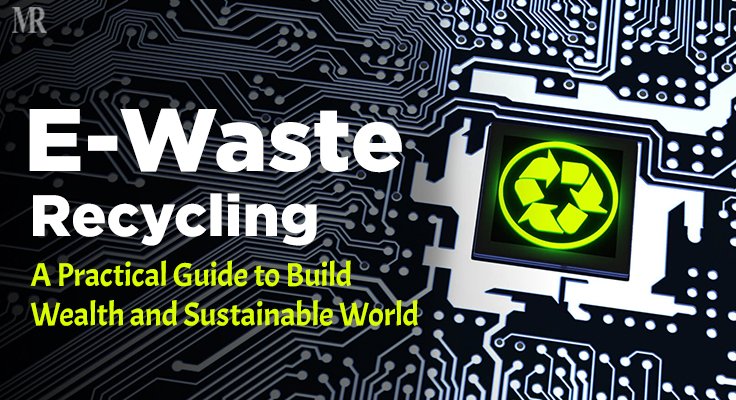E-waste recycling, which involves the responsible disposal of discarded electronic devices and gadgets that have reached the end of their useful lives, has become a pressing environmental and health concern due to the rapid advancement of technology. This category encompasses old computers, smartphones, TVs, refrigerators, and other electronic equipment. Global electronic waste production has soared, making it crucial for us to address the challenges posed by this crisis.
The global e-waste crisis is a pressing issue that demands immediate attention and collective action. Recognizing the dangers of improper e-waste disposal and embracing responsible recycling practices can mitigate the environmental impact and protect human health. Governments, industries, and individuals must collaborate to establish effective recycling systems and promote awareness about the benefits of e-waste recycling. Only through concerted efforts can we pave the way toward a sustainable future where electronic waste is managed responsibly and valuable resources are conserved for generations to come.
A Cause for Concern
In 2023, the global e-waste generation reached a staggering 53.6 million metric tons, reflecting a 4.2% increase from 2022. Despite growing awareness about responsible waste disposal, the global e-waste recycling rate still needs to improve. In 2023, only 17.4% of the world’s electronic waste was recycled, leaving a staggering 82.6% unaccounted for in landfills and incinerators. This calls for urgent action to promote effective recycling practices and sustainable solutions.
Top E-Waste Generating Countries:

Problem with E-Waste
The surge in electronic waste poses numerous challenges and risks to our planet and its inhabitants:
- Environmental Hazards: E-waste contains toxic substances like lead, mercury, cadmium, and flame retardants. When improperly disposed of in landfills or incinerated, these harmful chemicals leach into the soil and water, contaminating the environment.
- Health Impacts: Informal electronic waste recycling practices in some regions expose workers to hazardous substances, leading to severe health problems like respiratory issues, skin diseases, and neurological disorders.
- Resource Depletion: Electronics often contain valuable materials like gold, silver, and rare earth metals. Failing to recycle e-waste means missing an opportunity to recover and reuse these valuable resources.
Benefits of E-Waste Recycling
Amidst the electronic waste crisis, responsible recycling offers significant advantages:
- Environmental Preservation: Recycling e-waste helps prevent toxic substances from polluting the environment, safeguarding ecosystems and wildlife.
- Resource Conservation: Extracting raw materials from the earth for new electronic products consumes vast amounts of energy and depletes natural resources. Recycling reduces the need for such extraction, conserving valuable materials.
- Energy Efficiency: Producing electronic devices from recycled materials requires less energy compared to manufacturing from scratch, contributing to energy conservation and reducing greenhouse gas emissions.
- Job Creation: Formal electronic waste recycling facilities can generate employment opportunities, providing safe and sustainable livelihoods for workers involved in the recycling process.
Top E-Waste Recycling Countries:

Recycling E-Waste: From Collection to End Market
As the global e-waste crisis intensifies, the need for a well-structured and efficient recycling chain becomes increasingly vital. The journey of e-waste from collection to preparation for the end market plays a crucial role in mitigating environmental hazards and conserving valuable resources. Let’s explore the essential steps in the recycling electronic waste chain.
- Collection
The first step in the e-waste recycling chain is the collection of electronic devices that have reached the end of their life cycle. This process involves various stakeholders, including individuals, businesses, and municipalities. Collection points, drop-off centers, and recycling events are set up to encourage proper e-waste disposal. Responsible collection ensures that discarded electronics are diverted from landfills and informal recycling practices.
- Processing
Once collected, electronic waste undergoes processing at specialized recycling facilities. The devices are disassembled during this phase, and hazardous materials, such as lead, mercury, and cadmium, are carefully extracted. The goal is to prevent these harmful substances from polluting the environment during further recycling or disposal.
- Data Destruction and Security
Data security is a critical concern during recycling e-waste. Proper measures are taken to erase any sensitive information stored in the devices permanently. Certified data destruction techniques safeguard individuals and businesses from potential data breaches.
- Component Recovery
After processing, the recycling facility focuses on component recovery. Valuable materials like gold, silver, copper, and rare earth metals are extracted from electronic devices. Recovering these resources reduces the need for raw material extraction and conserves valuable natural resources.
- Preparation for End Market
The final stage in the recycling e-waste chain involves preparing the recovered materials for the end market. These materials are sold to manufacturers who use them as secondary raw materials to produce new electronic products. Proper preparation ensures that the recycled materials meet quality standards and are suitable for manufacturing processes.
Tackling the Hurdles: The Challenges
As technology continues to evolve at an unprecedented pace, so does the generation of electronic waste. Disposing of electronic devices, ranging from smartphones to computers, has become a pressing global concern. While recycling e-waste presents a promising solution, several challenges hinder its effective implementation.
- Lack of Awareness
One of the primary obstacles to the recycling of e-waste is the need for greater awareness among consumers and businesses alike. Many individuals remain unaware of the environmental and health hazards posed by improper disposal of electronic devices. Consequently, many discarded electronics are in landfills, leading to harmful chemicals seeping into soil and water sources.
Solution: Raising Awareness Campaigns
- Poor Infrastructure
Inadequate infrastructure for recycling e-waste poses a significant challenge in many regions. Some areas need designated collection centers or recycling facilities, making it difficult for individuals and businesses to dispose of their electronic waste responsibly. The recycling process can also be complex and require specialized equipment and technologies.
Solution: Strengthening Recycling Facilities
- Illegal Dumping
One of the most concerning challenges in e-waste recycling is illegal dumping. Some unscrupulous entities, driven by cost-cutting motives, choose to dispose of electronic waste in environmentally sensitive areas or developing countries with lax regulations. This dangerous practice harms the environment and poses health risks to vulnerable populations.
Solution: Strengthening Regulations and Enforcement
Be the Change in Recycling
Addressing the challenges of e-waste recycling requires collective action, and as individuals, we all have a crucial role to play in creating a sustainable future. We can make a significant difference in managing electronic waste responsibly by taking simple yet impactful steps.
- Recycle Your E-Waste
The first step towards responsible electronic waste management is properly recycling your electronic devices. Instead of discarding old or broken gadgets with regular household waste, find certified e-waste recycling centers or drop-off locations in your community. Recycling prevents hazardous materials from ending in landfills and ensures that valuable components and materials are recovered and reused. Remember to wipe your personal data from devices before recycling them, ensuring your privacy is protected. Many recycling centers offer data wiping services or provide guidance on how to do it safely.
- Support Companies Committed to Recycle E-Waste
When purchasing new electronic devices, choose products from companies committed to sustainable practices, including recycling e-waste. Look for brands that offer take-back programs, where they take responsibility for recycling their products at the end of their lifecycle. Supporting such companies sends a powerful message that responsible electronic waste management is a consumer priority. Additionally, consider opting for products made from recycled materials, contributing to the demand for more eco-friendly manufacturing practices.
- Advocate for Better Recycling Policies
As consumers, our collective voice can drive change. Advocate for stronger e-waste recycling policies at local, national, and international levels. Support organizations and initiatives working towards improving recycling regulations and enforcing stricter penalties for illegal dumping. Engage with your local government representatives, attend town hall meetings, and raise awareness about the importance of responsibly recycling e-waste in your community. The more people are aware of the issue, the more likely policymakers will take action.
Opportunities to Grab

The e-waste recycling industry is a growing industry with several opportunities. The global e-waste generation rate is expected to increase in the coming years, creating a need for more recycling facilities and services. By investing in this industry, you can help to reduce the environmental impact of e-waste and conserve natural resources.
Here are some of the opportunities in the industry:
- Collection and transportation: There is a need for companies to collect and transport e-waste from businesses and individuals. This can be done through curbside collection programs, drop-off centers, and buyback programs.
- Processing and recycling: There is a need for companies to process and recycle e-waste. This involves removing hazardous materials and recovering valuable components.
- Disassembly and refurbishment: There is a need for companies to disassemble and refurbish e-waste. This can extend the life of electronic devices and reduce the amount of e-waste that needs to be recycled.
- Manufacturing of recycled materials: There is a growing demand for recycled materials from e-waste. These materials can be used to make new products, such as batteries, circuit boards, and plastics.
- Research and development: There is a need for research and development in the e-waste recycling industry. This can lead to new and improved methods for collecting, processing and recycling electronic waste.
Here are some specific examples of companies that are taking advantage of the opportunities in the industry:
- Envirocycle is a company that collects and recycles e-waste from businesses and individuals. They have a network of over 10,000 collection points in the United States.
- TES Recycling is a company that processes and recycles e-waste. They have a state-of-the-art facility in Texas that can process over 100,000 tons of e-waste annually.
- Simply Green is a company that refurbishes e-waste. They have a team of experts who can disassemble and refurbish electronic devices, extending their lifespan and reducing the amount of e-waste that needs to be recycled.
These are just a few examples of the many companies taking advantage of the opportunities in the industry. If you are looking for a way to invest in a growing and sustainable industry, the e-waste recycling industry is a great option.
E-waste recycling is a shared responsibility, and every individual’s actions count. Together, we can positively impact the environment, conserve valuable resources, and protect our planet from the growing challenge of electronic waste. Let us take action today to create a better tomorrow for future generations. We hope this blog has helped you to understand the importance of recycling electronic waste.
Keep Reading! Keep Growing!
Also Read: An Essential Guide to Know About Battery Technology and Its Innovative Advancements












